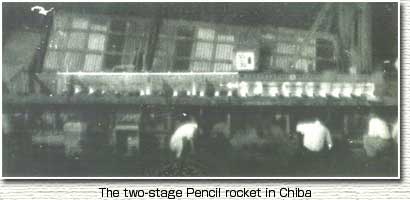 |
 |
|
|
After the experiments at Kokubunji, a test water-tank for marine vessels at the Chiba campus of the Institute of Industrial Science (IIS) under the University of Tokyo was modified and used as a pit for further tests. Some valuable experience was gained through repeated horizontal launches of the 300-mm-long Pencil rocket (Pencil 300), the two-stage Pencil rocket, and the Pencil rocket without tail wings, etc.
During a ground experiment in April 1955, a Pencil rocket flew about 10 to 20 meters horizontally and although I didn't participate in these tests, from about June that year, a two-stage Pencil rocket was also tested using the water-tank at the IIS. At that time, the electronics were unreliable under the rapid accelerating circumstances, so for a while, we had to use a mechanical method for the second stage ignition. The Pencil rocket also helped us learn about such technical aspects step by step. (Akiba)
I almost died when we tested the two-stage Pencil rocket using the test water-tank at the ISS in Chiba. As you know, it was a two-stage Pencil rocket, so it had a main rocket and a booster rocket. We made such a small two-stage rocket that the main rocket was designed to ignite some 1/10th of a second after the booster rocket's ignition. So, the battery for the power supply was also specifically made for this purpose.
I suspect the person who wired it might have made a mistake. As I didn't know anything about that aspect, I put the main rocket into the launcher and held the booster rocket trying to place it behind the main rocket in the launcher. The booster rocket was supposed to ignite first, but the main rocket was ignited first.
I'll tell you what could have happened if I had been holding the main rocket. The tail wings on the main rocket would have cut off all my fingers. I was lucky I held the booster rocket instead, but as the main rocket was ignited, all the propellant grains from the ignition ripped through the skin of my two hands. The next day, I went to Ogikubo Hospital and got all the grains removed with a scalpel. I remember my hands took about a month to completely heal. (Kakimi)
So, for a while we stopped using the dangerous two-stage ignition system and used a system to allow a delay to ignite the second stage rocket by using an appropriate length of fuse. The Pencil rocket was meaningful for us as we slowly learned technical aspects about rockets. I think it's not fair to say that the Pencil rocket did not make any major achievements and was just a demonstration model because it was small. We learned a good deal from it. (Akiba)
There are various ways of evaluating the achievements of the Pencil rocket, but its crowning achievement was that it led to the creation of a development system. The other aspect is that the development of the Pencil rocket was not started for the purpose of space observation at the beginning. At the time of restarting aeronautical research after interruptions, Professor Itokawa said, " Let's think about aeronautics and space," and focused his attention on rockets and established a research group. The project was originally raised from an engineering viewpoint. (Akiba)
|
|
 |
 |
 |
(7/15) |
 |
|
 |